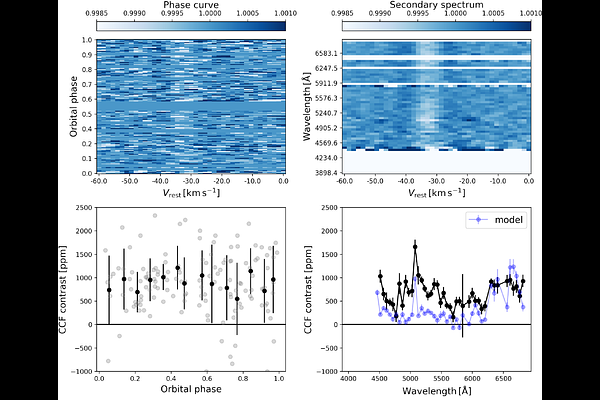EBLM XV -- Revised dynamical masses for the circumbinary planet host Kepler-16 AB, using the SOPHIE spectrograph

EBLM XV -- Revised dynamical masses for the circumbinary planet host Kepler-16 AB, using the SOPHIE spectrograph
D. Sebastian, I. Boisse, A. Santerne, A. H. M. J. Triaud, T. A. Baycroft, Y. T. Davis, M. Deleuil, S. Grouffal, G. Hébrard, N. Heidari, D. V. Martin, P. F. L. Maxted, R. P. Nelson, Lalitha S., M. G. Scott, O. J. Scutt, M. Standing
AbstractEclipsing binaries are perfect laboratories to measure precise, accurate and model-independent stellar radii and stellar masses, so long as both components are spectroscopically resolved. Resolving both components is difficult in high-contrast binaries, for instance, those composed of an FGK main-sequence star with an M-type companion. In those cases, the secondary can contribute <1% of the total flux in optical wavelengths. This makes measuring dynamical masses challenging and has typically only been attempted with large-aperture telescopes (8-10-m). The High-Resolution Cross-Correlation Spectroscopy (HRCCS) method was developed to extract weak emission and transmission spectra for exoplanet atmospheres. This method was recently adapted and applied to measure dynamical masses in high-contrast binaries. In this work, we apply the HRCCS method to optical spectra of the high-contrast binary and circumbinary planet host Kepler-16AB, obtained with the SOPHIE spectrograph at the 1.93-m telescope at the Observatoire de Haute-Provence. The secondary, which has a contrast ratio of ~ 6 x 10-3, is resolved with a detection significance of 9.5-sigma. We derive dynamical masses with a precision of 1.5% and 0.9% for the primary and secondary respectively. These are comparable, but slightly higher (within 2-7%) to previous mass-measurements, which has -- within the uncertainties -- no implication for the mass of the known circumbinary planet. This work demonstrates that dynamical mass measurements of high-contrast binaries can be done with 2-m class telescopes. We also investigate different analysis protocols to ensure we derive robust uncertainties for dynamical masses.